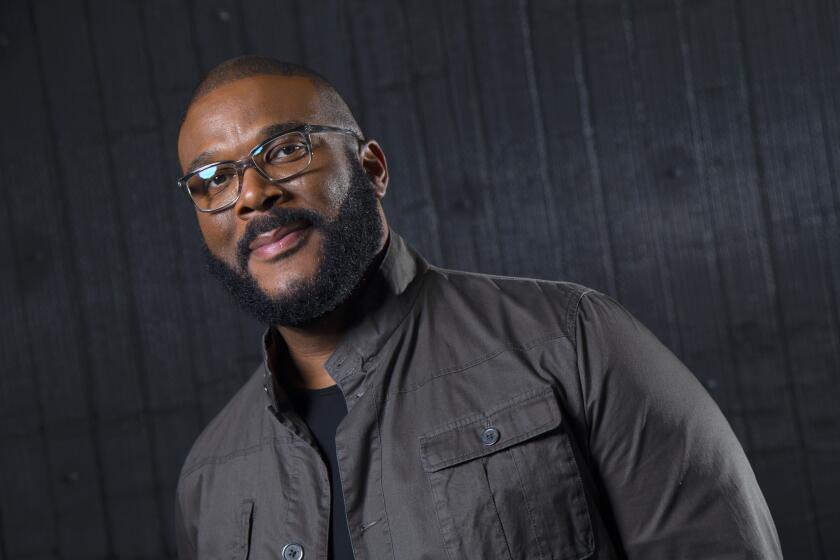‘Love, Loss, and What I Wore’ at Geffen Playhouse has plenty of drama backstage too
- Share via
Phyllis Schuringa, the casting director at the Geffen Playhouse, was thrilled to book Lauren Hutton for the sixth cast of “Love, Loss and What I Wore,” now playing at the Audrey Skirball Kenis Theater.
But she was startled by the fashion icon’s one stipulation: Hutton doesn’t wear black.
“Wearing black is kind of a conceit of the show,” said Schuringa, putting it mildly.
To watch “Love, Loss” — in which five black-clad women sit in chairs on a bare stage, scripts before them, and read monologues about clothes and the memories they evoke — is to understand that, for the authors, Nora and Delia Ephron, wearing black is less a style than a worldview, practically a religion. Several of the characters admit to buying more black turtleneck sweaters than they need. “Can’t we just stop pretending that anything is ever going to be ‘the new black’?” one demands.
But, it seems, there are dissenters in the ranks.
“Lauren’s thing is that white really makes the face ‘pop,’ ” explained Jenny Sullivan, who directed the L.A. production. “She brought in this black dress with a great jacket and tried it on with a white blouse. There was just a little white peeking out. I said, ‘I’m just going to have to run this by Nora and Delia because that’s not the way they wrote it.’ ” Hutton agreed to try it without the blouse. “And she looked fabulous, of course,” Sullivan said.
Hutton ultimately signaled her heterodoxy through accessories, adding a string of white pearls and a fresh flower.
After seven months with seven casts, the team behind the scenes at “Love, Loss and What I Wore” might consider writing an advice book on managing dramatic women. Looking slightly dazed, like a trio of Cinderellas after preparing 35 stepsisters for 200 balls, Sullivan, Schuringa, and production stage manager Young Ji sat down recently to reminisce about loves, losses and wardrobe emergencies backstage. Wardrobe stylist Alex Jaeger later weighed in via telephone from San Francisco. The final cast — Renee Taylor, Mimi Rogers, Sandra Tsing Loh, Romy Rosemont and Marianna Palka — is now performing the show, which will close Friday.
It’s a little misty, they all admitted, but certain moments do stand out: When Meredith Baxter broke character to ask the owner of a continuously ringing cellphone to leave the theater. The night Erica Ash walked offstage mid-show (She had to go to the bathroom.). The challenge of costuming Bonnie Franklin, who had just shattered her wrist and wore what Sullivan described as “one of those external fixator things, with the screws going through the arm.” (They wrapped it in a black Ace bandage.) The time somebody’s outfit didn’t come back from the dry cleaner and Jaeger, who was out of town, had to talk a wardrobe assistant through finding a replacement from the rack.
Fittingly, many challenges have been clothing-related. But there were plenty of others. With a new quintet to hire, rehearse, dress and tend to each month, the team found itself functioning as chaperones, counselors, teachers, nurses and even babysitters (Kathryne Dora Brown’s newborn stayed in a makeshift nursery backstage).
“One of my favorite memories is seeing Young [Ji] running down the hall with five purses over his shoulder,” said Sullivan.
Ji, the one consistent male presence, assumed a role on the set that combined Mary Poppins, father, younger brother, therapist and bodyguard. “The ladies loved to make him blush — they’d invite him into the dressing room when not everybody was completely dressed,” said Sullivan, “but he really comforted them.”
He walked every actress to her car after each performance to shield her from aggressive fans.
He can recite the entire 90-minute show by heart.
In a recent conversation, Schuringa was still processing the idea that she didn’t have to book five more actresses. Slated initially for a 3-month run with three casts, “Love, Loss” proved so popular — not even its stars could get tickets — that it was extended three times. To fill the 35 spots, she made 94 offers. After two last-minute dropouts, the seventh cast was finalized at 2p.m. on the Saturday before the opening.
The Ephron sisters helped select the first cast (four of the five stars had appeared in the New York production) and approved the others. They laid out parameters: Gingy, whose epigrammatic sartorial reminiscences (from the book “Love, Loss, and What I Wore,” by Ilene Beckerman) form the dramatic spine of the show, should be more than 60 years old. Of the four remaining cast members, one should be “a little overweight”; one should have “some sort of ethnicity”; they should represent a range of ages.
“And of course having some celebrity is good,” added Schuringa. “Some people that the audience will recognize.”
Gingy’s is the only fixed part. The other monologues, based on the experiences of the Ephrons and their friends (who are thanked in the program but not credited with particular stories), are distributed among the rest of the cast. Sullivan said that, given the choice, everybody would have lobbied for “I Hate My Purse.”
“That’s the one that really jumps off the page,” she said. Following the Ephrons’ advice, however, Sullivan did not involve the actresses in the assignments.
Each new cast arrived on a Monday, had two days of rehearsal, including a costume fitting, and two previews, then opened on Thursday night.
Jaeger had learned each actress’ size and studied photographs to get a sense of her style before combing the stores and assembling his selections on groaning racks. The first cast went up to be fitted together. “It was like letting them loose at a sale,” he recalled. Sullivan sent subsequent casts to wardrobe one by one.
“Whenever possible, we tried to get Eileen Fisher onto Gingy,” said Sullivan, referring to one of the play’s more divisive lines, “You know you have given up when you go to Eileen Fisher.” “It didn’t always happen, but it was a goal.”
The intense pace of opening week and sharing a communal dressing room led to rapid bonding, a team spirit, and a summer camp feeling among most casts. Careers took new turns and friendships formed — Sullivan was pleased to see Baxter in the front row when her fellow cast member Florence Henderson premiered on “Dancing With the Stars.”
The script itself may be the real catalyst for intimacy — among the cast and with the audience. “The actresses often get really emotional,” said Sullivan, especially the two playing a lesbian couple, who, after describing their separate quests for wedding clothes, turn to each other and exchange vows. “I’ve been trying to reel it in — because we’ve got to get through it! But it’s not an acting choice. It just hits them.”
The show doesn’t dwell on the darker side of female friendships (a la “The Real Housewives of…” series). Even so, teamwork can take a person only so far. Selecting the group photograph of the first few casts stumped the Geffen’s publicity director. “In the beginning I gave them photo approval.” The stars each crossed out the proofs they didn’t like, leaving her nothing to print.
“I stopped giving them photo approval,” she said.
More to Read
The biggest entertainment stories
Get our big stories about Hollywood, film, television, music, arts, culture and more right in your inbox as soon as they publish.
You may occasionally receive promotional content from the Los Angeles Times.










